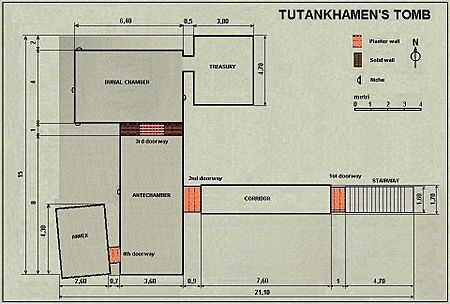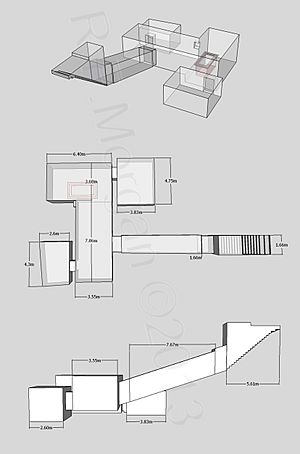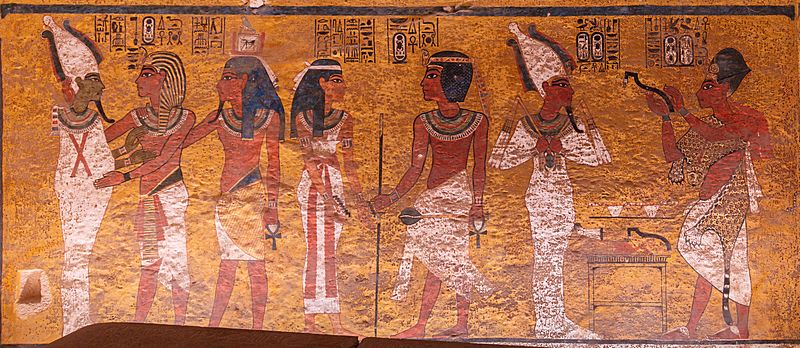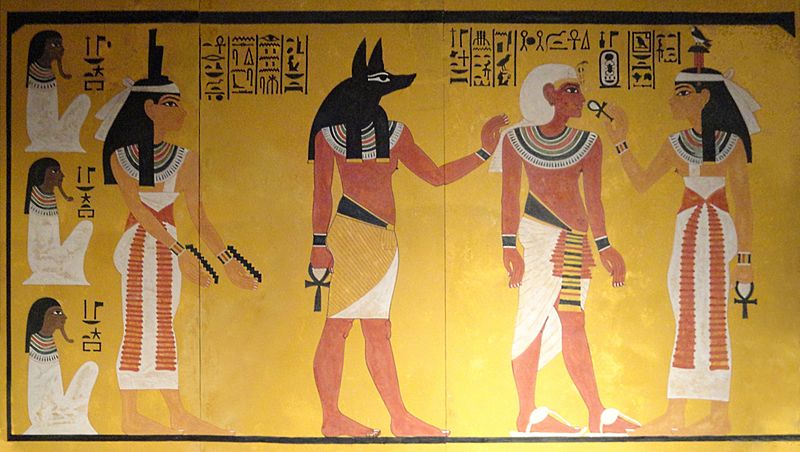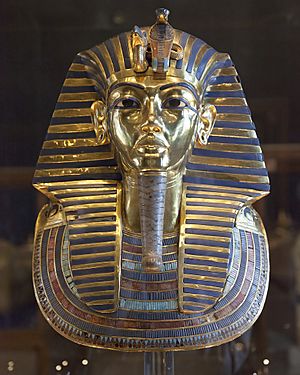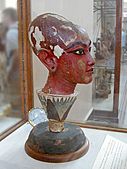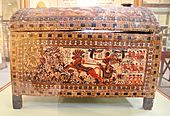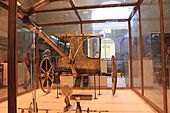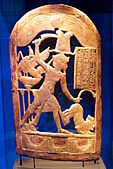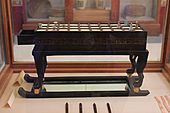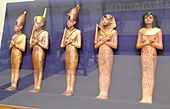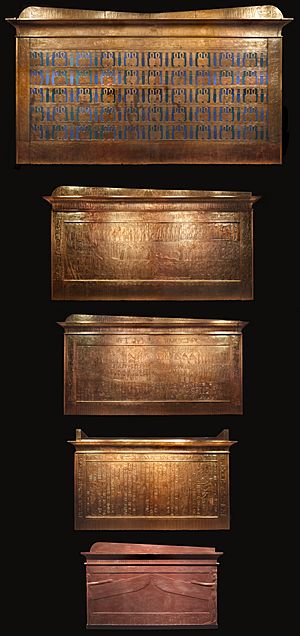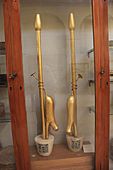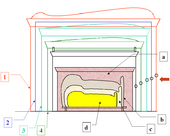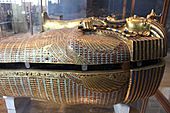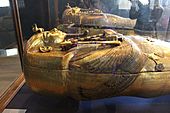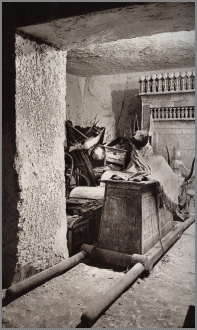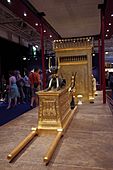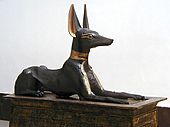Tomb of Tutankhamun facts for kids
Quick facts for kids KV62 |
|||
|---|---|---|---|
| Burial site of Tutankhamun | |||

The wall decorations in KV62's burial chamber
are modest in comparison with other royal tombs found in the Valley of the Kings. |
|||
| Coordinates | 25°44′25.4″N 32°36′05.1″E / 25.740389°N 32.601417°E | ||
| Location | East Valley of the Kings | ||
| Discovered | 4 November 1922 | ||
| Excavated by | Howard Carter | ||
| Decoration |
|
||
| Layout | Bent to the right | ||
|
|||
The tomb of Tutankhamun, also known as KV62, is the burial place of Tutankhamun. He was a pharaoh (king) of ancient Egypt's Eighteenth Dynasty. His tomb is located in the famous Valley of the Kings.
This tomb has four rooms and an entrance staircase and corridor. It is smaller and less decorated than other royal tombs from that time. It was likely first built for someone who wasn't a king. But it was changed for Tutankhamun after he died young. Like other pharaohs, Tutankhamun was buried with many special items. These included coffins, furniture, clothes, and jewelry. Because the tomb was small, these goods were packed in tightly.
Robbers broke into the tomb twice shortly after Tutankhamun was buried. However, Tutankhamun's mummy and most of his treasures remained safe. The tomb was dug low into the valley floor. This helped hide its entrance under dirt and rocks from floods and other tomb building. So, unlike many other tombs, its valuable items were not stolen during the Third Intermediate Period (around 1070–664 BC).
Tutankhamun's tomb was found in 1922 by Howard Carter and his team. The huge amount of amazing treasures inside caused a lot of excitement worldwide. It became the most famous discovery in the study of ancient Egypt, called Egyptology. Carter's helper, the Earl of Carnarvon, died during the digging. This led to stories about a "curse" on the tomb. The discovery didn't tell us much new about Tutankhamun's rule. But it showed us a lot about the daily life and valuable items of wealthy ancient Egyptians. It also taught us about how tombs were robbed long ago. Tutankhamun became one of the most famous pharaohs. Some items from his tomb, like his golden burial mask, are among the most famous artworks from ancient Egypt.
Most of the tomb's treasures were sent to the Egyptian Museum in Cairo. They are now in the Grand Egyptian Museum in Giza. However, Tutankhamun's mummy and sarcophagus (stone coffin) are still in the tomb. Floods and many tourists have caused some damage to the tomb since it was found. A copy of the burial chamber has been built nearby. This helps reduce the number of visitors to the real tomb.
Contents
Exploring the Tomb's Design
Tutankhamun's tomb is in the eastern part of the Valley of the Kings. This is where most tombs in the valley are found. It was carved into the limestone rock of the valley floor. Its design is like non-royal tombs of its time. But it was made grander to look like a king's tomb.
The tomb has a stairway that goes down (called A). Then there's a corridor that also goes down (B). Next is an antechamber (I), which is like a waiting room. An annexe (Ia) is a side room next to the antechamber. The burial chamber (J) is where the king was buried. Finally, there's a room called the treasury (Ja). The burial chamber and treasury might have been added later. This happened when the tomb was changed for Tutankhamun.
Most royal tombs from the Eighteenth Dynasty had a "bent axis" layout. This meant you would turn sharply left to reach the burial chamber. But KV62's burial chamber is north of the antechamber. This gives it a bent axis that turns to the right instead.
The entrance stairs go down steeply. They originally had sixteen steps. The bottom six steps were removed during the burial. This made it easier to move large items through the door. They were rebuilt, then removed again 3,400 years later by the excavators. The corridor is 8 metres (26 ft) long and 1.7 metres (5 ft 7 in) wide. The antechamber is 7.9 metres (26 ft) long by 3.6 metres (12 ft) wide. The annexe is 4.4 metres (14 ft) long by 2.6 metres (8 ft 6 in) wide. The burial chamber is 4 metres (13 ft) long by 6.4 metres (21 ft) wide. The treasury is 4.8 metres (16 ft) long by 3.8 metres (12 ft) wide. The rooms are between 2.3 metres (7 ft 7 in) and 3.6 metres (12 ft) high. The floors of the annexe, burial chamber, and treasury are about 0.9 metres (2 ft 11 in) lower than the antechamber.
Limestone and plaster walls originally sealed the doorways. These were between the stairway and corridor, corridor and antechamber, antechamber and annexe, and antechamber and burial chamber. Robbers broke through all of them. Most were sealed again by restorers. But the hole in the annexe doorway was left open.
Art and Decorations Inside
The plaster walls had marks from seals. These seals belonged to officials who oversaw Tutankhamun's burial. The marks had hieroglyphic writing. They praised Tutankhamun's service to the gods.
The only wall decoration in the tomb is in the burial chamber. This is unusual for royal tombs of that time. Other tombs often had more decorated rooms. None of the art is carved in relief. This carving style was not used in the Valley of the Kings until later.
The burial chamber walls are painted on a yellow background. The east wall shows Tutankhamun's funeral procession. This type of image is common in private tombs. But it is not found in other royal tombs. The north wall shows Ay performing the Opening of the Mouth ritual on Tutankhamun's mummy. This made Ay the rightful king. It also shows Tutankhamun greeting the goddess Nut and the god Osiris in the afterlife. The south wall showed the king with the gods Hathor, Anubis, and Isis. Part of this wall's art was on the wall separating the burial chamber from the antechamber. So, the figure of Isis had to be removed when that wall was taken down. The west wall has an image of twelve baboons. This is from the first part of the Amduat. The Amduat is a funerary text that describes the sun god Ra's journey through the underworld.
On three walls, the figures have unusual shapes. This is typical of the Amarna art style. But the south wall goes back to the usual shapes seen before and after the Amarna period.
Treasures of the Tomb
The tomb's contents are the most complete set of royal burial items found in the Valley of the Kings. There were 5,398 objects in total! Some types of objects numbered in the hundreds. For example, there were 413 shabtis. These were small statues meant to work for the king in the afterlife. There were also over 200 pieces of jewelry. Objects were found in all four rooms and the corridor.
The robbers, and then the quick restoration, left much of the tomb messy. By the time it was found, many objects were damaged. This was due to changes between wet and dry conditions. Most leather had turned into a sticky mess. Some fabrics had become black powder. Wooden items were bent and their glue had dissolved. This made them very fragile. Every exposed surface had a pink film. This might have been from iron in the rock or plaster.
To clean and remove the damaged items, the excavators labeled each one. They used numbers from 1 to 620. Letters were added for individual items in a group.
Outer Chambers and Their Finds
The corridor might have held things like bags of natron (a salt used in mummification), jars, and flower garlands. These were moved when the corridor was filled after the first robbery. Other items were found mixed into the corridor's fill. A famous item, a wooden bust of Tutankhamun, was found in the corridor. But it wasn't in Carter's first notes.
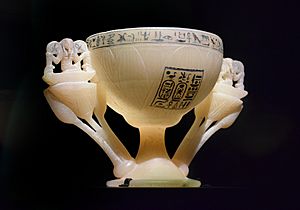
The antechamber held 600 to 700 objects. Its west side had a pile of furniture. Small items like fruit baskets and meat boxes were placed among them. Several taken-apart chariots were in the southeast corner. The northeast had many funeral flower arrangements. Two life-size statues of Tutankhamun stood at the entrance to the burial chamber. These statues might have guarded the burial chamber. Or they might have shown the king's ka (a part of his soul).
Important items in the antechamber included several funeral beds with animal heads. These were a big part of the furniture pile. There was also an alabaster lotus chalice. A painted box showed Tutankhamun in battle. Carter thought it was one of the best artworks in the tomb. Carter liked a gilded and inlaid throne even more. It showed Tutankhamun and Ankhesenamun in the Amarna art style. He called it "the most beautiful thing that has yet been found in Egypt."
Boxes in the antechamber held most of the tomb's clothing. This included tunics, shirts, kilts, gloves, and sandals. Cosmetics like perfumes and kohl were also found. Gold and jewels from a corselet (ceremonial armor) were scattered around. Rebuilding this corselet was very hard for the excavators. This room also had a wooden dummy of Tutankhamun's head and body. Its purpose is not clear. But it might have worn a corselet. Carter thought it was a mannequin for the king's clothes.
The annexe held over 2,000 items. Its original contents were mixed up. Objects had been put back carelessly after the robberies. These included beds, stools, and stone and pottery jars. The jars held wine and oils. This room had most of the tomb's food. It also had most of the shabtis and many wooden funeral models, like model boats. Much of the tomb's weapons were found here. These included bows, throwing sticks, and khopesh-swords. Ceremonial shields were also in this room. Other items in the annexe were personal things Tutankhamun used as a child. These included toys, a box of paints, and a fire-lighting kit.
-
A senet game-board from the annexe
The Burial Chamber's Secrets
Most of the burial chamber was filled by a large, gilded wooden outer shrine. This shrine held three smaller shrines, one inside the other. Inside these was a stone sarcophagus. The sarcophagus held three nested coffins. A wooden frame stood between the outermost and second shrines. It was covered with a blue linen cloth decorated with bronze rosettes.
Even this chamber had burial goods. These included jars, religious items like imiut fetishes, oars, fans, and walking sticks. Some were placed in the small spaces between the shrines. Each wall of the chamber had a niche with a "magic brick." These bricks had spells from the Book of the Dead. They were meant to protect the dead king.
The shrines were decorated with carvings. These carvings showed parts of several funeral texts. All four shrines had parts of the Book of the Dead. More parts of the Amduat were on the third shrine. The outermost shrine had the earliest known copy of the Book of the Heavenly Cow. This text tells how the god Ra shaped the world. The second shrine had a funeral text found nowhere else. It describes the sun god and the underworld using a secret form of hieroglyphic writing.
The sarcophagus is made of quartzite. Its lid is red granite, painted yellow to match. It is carved with four protective goddesses: Isis, Nephthys, Neith, and Serqet. Inside was a golden, lion-headed bed. On this bed rested three nested coffins shaped like a human.
The outer two coffins were made of gilded wood. They were decorated with glass and jewels. The innermost coffin was also decorated. But it was mainly made of 110.4 kilograms (243 lb) of solid gold. Inside it was Tutankhamun's mummified body. On his body, wrapped in layers of mummy cloth, were 143 items. These included sandals, many amulets and other jewelry, and two daggers. Tutankhamun's head wore a beaded skullcap and a gold crown. All of this was inside the golden mask of Tutankhamun. This mask is one of the most famous ancient Egyptian items in the world.
The Treasury's Riches
At the treasury's doorway stood a shrine on carrying poles. It had a statue of the jackal god Anubis on top. In front of it was a fifth magic brick. Against the east wall was a tall, gilded shrine. This shrine held the canopic chest. This chest contained Tutankhamun's internal organs after mummification. Most canopic chests have separate jars. But Tutankhamun's was a single block of alabaster. It was carved into four sections. Each section had a human-headed stopper. Inside each was a small, inlaid gold coffin that held one of the king's organs.
Between the Anubis shrine and the canopic shrine was a wooden sculpture of a cow's head. This represented the goddess Hathor. The treasury held most of the tomb's wooden models. These included more boats and a model granary. Many shabtis were also here. Boxes in the treasury held various items, including much of the tomb's jewelry. A set of small coffins in the treasury held a lock of hair. It belonged to Tiye, the wife of Amenhotep III. She is thought to be Tutankhamun's grandmother. One box held two tiny coffins. These contained the mummies of Tutankhamun's stillborn daughters.
-
A portable shrine with an Anubis statue, shown in Paris
-
A pendant shaped like a winged scarab with the Eye of Horus, from the treasury
Why the Tomb is Important
The huge number of items in Tutankhamun's tomb is often seen as a sign. It suggests that kings who lived longer and had bigger tombs were buried with even more objects. But Tutankhamun's burial items barely fit into his tomb. So, some experts believe larger tombs might have had similar amounts of items. They were just arranged more neatly.
Broken pieces of burial goods in other Valley of the Kings tombs show many of the same items as Tutankhamun's. This means there was a somewhat standard set of objects for royal burials back then. The life-size statues of Tutankhamun and the small statues of gods are similar to those in other tombs. The small statues of Tutankhamun himself are very similar to wall paintings in KV15, the tomb of Seti II.
Funeral models, like Tutankhamun's model boats, were mostly used in older kingdoms. They became less popular in non-royal burials later on. But several royal tombs in the Valley of the Kings still had them. On the other hand, Tutankhamun's tomb had no funeral texts on papyrus. This was unlike private tombs of his time. But a papyrus from KV35, the tomb of Amenhotep II, had a part of the Book of the Dead. This suggests that the lack of papyrus in Tutankhamun's tomb might have been unusual.
No papyrus texts were found among the burial goods at all. This was a disappointment to Egyptologists. They hoped to find documents that would explain the history of the Amarna Period. Instead, the discovery's main value was showing us about the daily items of ancient Egypt. Among the furniture was a foldable bed. It is the only complete example known from ancient Egypt. Some boxes could be closed with a turning knob. Carter called them the oldest known examples of such a lock.
Other everyday items included musical instruments, like a pair of trumpets. There were also various weapons, including a dagger made of iron. Iron was rare in Tutankhamun's time. About 130 staffs were found. One even said, "a reed staff which His Majesty cut with his own hand."
Tutankhamun's clothes were loose tunics, robes, and sashes. They were often decorated with dyes, embroidery, or beads. They showed more variety than clothes in art from his time. That art mostly showed plain white kilts. No crowns were found in the tomb. But crooks and flails, which were symbols of kingship, were stored there. Some experts think crowns might not have been personal property. They might have been passed down from king to king.
Some objects in the tomb give us clues about the end of the Amarna Period. A piece of a box found in the corridor has the names of Akhenaten, Neferneferuaten, and Akhenaten's daughter Meryetaten. A jar from the tomb had two erased royal names. These have been identified as Akhenaten and Smenkhkare. These are important clues for figuring out the royal family's relationships. They also help understand the order in which kings ruled. However, experts have different ideas about what they mean. The faces on Tutankhamun's second coffin and his canopic coffinettes look different from most pictures of him. So, these items might have been made for another ruler first. Then they were reused for Tutankhamun's burial.
Some objects show the change in religious beliefs during Tutankhamun's rule. The golden throne shows Tutankhamun and Ankhesenamun under the sun's rays. This is in the Amarna art style. The king and queen are named with later forms of their names. These refer to Amun, not Aten. But there are signs that these names were changed after the throne was made. The open-work arms and back of the throne show the king's original name, Tutankhaten. A scepter from the annexe has writing that mentions both Aten and Amun. This suggests an attempt to combine the two religious systems.
Other information about the reign comes from wine jar labels. They show the year the wine was made. Jars clearly from Tutankhamun's reign range from Year 5 to Year 9. One jar from an unknown reign is labeled Year 10. Another is Year 31. The Year 31 wine probably came from the reign of Amenhotep III. So, the other jars suggest Tutankhamun ruled for nine or ten years. The flowers and fruits in the funeral garlands would have been available from mid-March to mid-April. This means Tutankhamun's funeral took place around that time.
The thefts make Tutankhamun's tomb a key source for understanding tomb robbery. It also shows how tombs were restored in the New Kingdom. Especially for the early part of that time. Robberies then were more by chance. They were not like the large-scale stealing that happened later. Many boxes in the tomb have notes in hieratic writing. These list their original contents. This helps us figure out what the tomb originally held and what was lost. For example, notes on jewelry boxes in the treasury show that about 60 percent of their contents are missing.
Thieves would have wanted things that were valuable, easy to carry, and hard to trace. Or things they could hide by taking apart or melting. Most metal and glass vessels buried with Tutankhamun were stolen. This shows that glass was valuable then. The robbers also took bedding and cosmetics. The theft of cosmetics shows the robberies happened soon after burial. This is because Egyptian perfumes, made with fat, would have gone bad within a few years. One box in the antechamber had gold rings wrapped in a scarf. Carter thought the thieves dropped them. Then restorers put them in the box. But it's unlikely robbers would forget something so valuable. So, he thought they might have been caught in the act. Broken objects in the corridor fill came from the antechamber. This means the first thieves only got into that room. The second group reached as far as the treasury.
A man named Djehutymose wrote his name on a jar stand in the annexe. He was likely the official who restored the tomb. The same man left a note in KV43, the tomb of Thutmose IV. It recorded that tomb's restoration in Year 8 of Horemheb's reign. These two tombs were among several in the Valley of the Kings that were robbed. This happened at the end of the Eighteenth Dynasty. It suggests that political problems after Tutankhamun's death made the tombs less safe.



